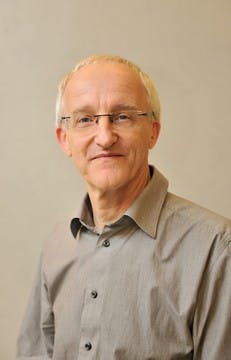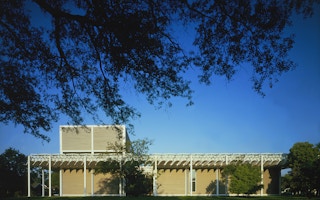How do you make people comfortable and productive with the minimum use of energy? Solving that puzzle has occupied Alistair Guthrie, the global leader of sustainable building design at professional services firm Arup, for the thirty-odd years of his career, and this is still the biggest challenge faced by people in his line of work, he says.
His solution is to change as little as possible and let the building’s natural conditions keep its internal climate stable: an unsurprising approach, coming from an engineer whose specialty is the application of building physics to sustainable and microclimate design.
“I always like to design spaces in a natural way. The physics of the building enclosure, air flow, heat flow, moisture flow, shading, glass, and insulation are essential to get right at the beginning of a project,” he explains.
Mr Guthrie joined Arup in 1979, and over the last three and a half decades, has been involved in the design of arts and culture, education, commercial and transport buildings around the world.
His favourite projects relate to arts and culture, such as the Menil Collection and the Kimbell Museum in Texas, the National Performing Arts and Library Complex in Athens, and the LEED Platinum rated California Academy of Sciences.
For many of these, he collaborated with international architectural practice Renzo Piano Building Workshop. He is also a visiting lecturer at the Royal College of Art and an Honorary Professor of Environmental Design in the School of Built Environment, Nottingham University.
This September, Mr Guthrie will be a plenary speaker at the International Green Building Conference (IGBC) 2014 in Singapore, sharing his expertise on collaborative integrated design along with other distinguished thought leaders. Here, he shares with Eco-Business some insights into the technical aspects of sustainable design.

Alistair Guthrie, Arup’s global sustainable buildings design leader. Image: Arup
What draws you to arts and culture projects in particular? Do the technical challenges differ from other types of projects you’ve worked on?
These are projects that enrich the social fabric of our cities. They are challenging because they represent big investments for a long time. Most will still be making a contribution in 50 years’ time. This means that the sustainability of the design solutions is very important.
Technically, arts and culture projects are challenging. Museums and galleries require precise environmental control, excellent lighting and daylighting, whilst seeking to minimise energy use. Performing arts buildings have complicated spaces to service, with very strict noise criteria.
Out of the many projects you’ve worked on, which is your favourite?
My favourite is probably the Menil Collection. It was the first project I worked on with Renzo Piano. Right from the beginning we sought to integrate the architecture and technical requirements of the museum into a single solution, the platform roof. We succeeded by shaping the structural leaves that form the roof to control the unwanted sunlight, reflect the daylight into the galleries and enhance the environmental control. The result is a stunning space that has inspired many of the museums we have designed since.
Why is it so challenging to balance comfort and productivity with energy efficiency?
Energy is required to modify the external climate, to create a comfortable internal climate. The old techniques for doing this use a lot of energy. We try to use the building itself, in a passive way, to reduce this. But the biggest challenge is providing clean fresh air at the right temperature and humidity, to match the number of people in the building. In some buildings this can use up to half of the operational energy, so controlling it effectively is one of our biggest challenges.
We are currently experimenting with a system that divides the office area into sections where the amount of fresh air can be adjusted to match the number of people present. We are looking at different ways to count the occupants.
Which aspects of sustainable design do you think should be more extensively developed in general?
There are two areas that I think are most important to our sustainable objective. Firstly, the building envelope: what it is made of, and its suitability to the climate. This will drive the internal environment, the feel of the space and the energy required to make it comfortable. It is essential that the building envelope responds to the climate. Many cities in the world have simply copied envelope solutions from other places which have completely different climate drivers, leading to uncomfortable, energy-hungry buildings.
For example, the value of some double façade solutions transferred from temperate Northern Europe to hot humid climates is questionable, and lightweight, steel and glass façades are generally much less efficient than more heavily constructed buildings in hot desert climates.
“
It is essential that the building envelope responds to the climate. Many cities in the world have simply copied envelope solutions from other places which have completely different climate drivers, leading to uncomfortable, energy-hungry buildings.
Secondly, the use of new technologies to minimise energy demand. New technologies in building systems and controls are being developed in different places across the world. We are looking at people-centred control, smart metering, energy storage, and DC circuits, all of which better match demand to requirements.
Many such technologies have been adopted worldwide including LED lighting and photovoltaic power generation. This worldwide adoption has driven down prices and improved the speed of innovation and efficiency. Regulation has a big part to play in the early adoption of both aspects of energy reduction and is country dependant.
When you embark on a new integrated design project, what’s the first thing you look at?

The Menil Collection opened in 1987 to preserve and exhibit the art collection of John and Dominique de Menil. Considered one of the most important privately assembled collections of the twentieth century, it houses about 17,000 paintings, sculptures, prints, drawings, photographs and rare books. Image: Arup
We like to set early directions for the project. This will include: what the client wants from his project, what environmental conditions need to be achieved, and how we can use the building and the climate together to achieve these goals.
We will also set a sustainability strategy which looks at how we will move the project towards being carbon neutral in operation, self-sufficient in water and built using sustainable materials.We will also look at any effect of climate change and strategies for transport, microclimate and biodiversity in the design. Sometimes we will identify the 10 most important points in the design.
In relation to a sustainable strategy, many clients are not sure how far they should push the agenda. We aim to help clients ‘imagine what is possible’ at the outset and on this basis, discuss the direction with them. For example, at the one meeting with a new client, I asked him: ‘Would you like me to tell you how it would be possible to make your project carbon neutral in operation?’ He said yes, we put a strategy together and although it was not fully realised in the finished building it provided a positive direction to the project.
What do you think designers and engineers should do to advance sustainable design?
Work together in an integrated collaborative manner. Set stretch goals for sustainability targets from the outset. Develop a climate responsive aesthetic, which contributes to the sustainability of the design in its widest sense. Make the project fit for people, its use, and the environment, not just for now, but for the next generation of occupants.













